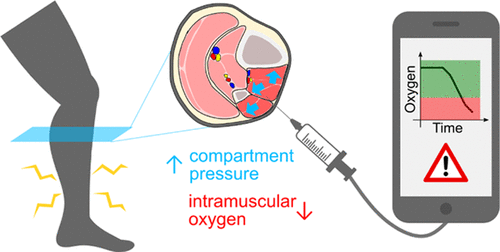Our official English website, www.x-mol.net, welcomes your
feedback! (Note: you will need to create a separate account there.)
Portable Oxygen-Sensing Device for the Improved Assessment of Compartment Syndrome and other Hypoxia-Related Conditions
ACS Sensors ( IF 8.2 ) Pub Date : 2020-12-16 , DOI: 10.1021/acssensors.0c01686 Lilian Witthauer 1 , Juan Pedro Cascales 1 , Emmanuel Roussakis 1 , Xiaolei Li 1 , Avery Goss 1 , Yenyu Chen 1 , Conor L. Evans 1
ACS Sensors ( IF 8.2 ) Pub Date : 2020-12-16 , DOI: 10.1021/acssensors.0c01686 Lilian Witthauer 1 , Juan Pedro Cascales 1 , Emmanuel Roussakis 1 , Xiaolei Li 1 , Avery Goss 1 , Yenyu Chen 1 , Conor L. Evans 1
Affiliation

|
Measurement of intramuscular oxygen could play a key role in the early diagnosis of acute compartment syndrome, a common condition occurring after severe trauma leading to ischemia and long-term consequences including rhabdomyolysis, limb loss, and death. However, to date, there is no existing oxygen sensor approved for such a purpose. To address the need to improve the assessment of compartment syndrome, a portable fiber-optic device for intramuscular oxygen measurements was developed. The device is based on phosphorescence quenching, where the tip of an optical fiber was coated with a poly(propyl methacrylate) (PPMA) matrix containing a brightly emitting Pt(II)-core porphyrin. The optoelectronic circuit is highly portable and is based on a microspectrometer and a microcontroller readout with a smartphone. Results from an in vivo tourniquet porcine model show that the sensor is sensitive across the physiological oxygen partial pressure range of 0–80 mmHg and exhibits an appropriate and reproducible response to changes in intramuscular oxygen. A commercial laboratory oxygen sensor based on a lifetime measurement did not respond as expected.
中文翻译:

便携式氧气传感装置,用于改善对室综合征和其他缺氧相关疾病的评估
肌内氧气的测量可能在急性区室综合征的早期诊断中起关键作用,急性室区综合征是严重创伤导致缺血和长期后果(包括横纹肌溶解,肢体丢失和死亡)后的常见情况。但是,迄今为止,尚无为此目的批准的氧气传感器。为了满足改善对隔室综合征的评估的需要,开发了一种用于肌内氧气测量的便携式光纤设备。该设备基于磷光淬灭,其中光纤的末端涂有含有明亮发光的Pt(II)核心卟啉的聚甲基丙烯酸丙酯(PPMA)基质。光电电路具有高度的便携性,并基于显微光谱仪和带有智能手机的微控制器读数。来自的结果体内止血带猪模型显示,该传感器在0-80 mmHg的生理氧分压范围内敏感,并且对肌内氧的变化表现出适当且可重现的响应。基于寿命测量的商业实验室氧气传感器未达到预期的响应。
更新日期:2021-01-22
中文翻译:

便携式氧气传感装置,用于改善对室综合征和其他缺氧相关疾病的评估
肌内氧气的测量可能在急性区室综合征的早期诊断中起关键作用,急性室区综合征是严重创伤导致缺血和长期后果(包括横纹肌溶解,肢体丢失和死亡)后的常见情况。但是,迄今为止,尚无为此目的批准的氧气传感器。为了满足改善对隔室综合征的评估的需要,开发了一种用于肌内氧气测量的便携式光纤设备。该设备基于磷光淬灭,其中光纤的末端涂有含有明亮发光的Pt(II)核心卟啉的聚甲基丙烯酸丙酯(PPMA)基质。光电电路具有高度的便携性,并基于显微光谱仪和带有智能手机的微控制器读数。来自的结果体内止血带猪模型显示,该传感器在0-80 mmHg的生理氧分压范围内敏感,并且对肌内氧的变化表现出适当且可重现的响应。基于寿命测量的商业实验室氧气传感器未达到预期的响应。











































 京公网安备 11010802027423号
京公网安备 11010802027423号